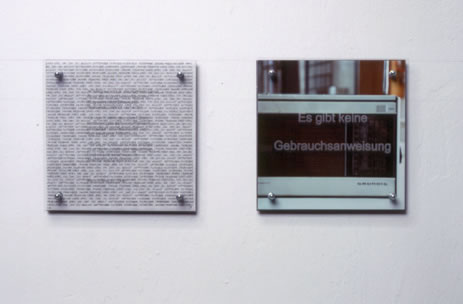
untitled
Perspex, screen print, paper,
text, steel
25 x 25 x 4.6 cm
1998
right
"Es gibt keine Gebrauchsanweisung"
[There are no instructions]
Perspex, milled, photographic print, steel
25 x 25 x 4,6 cm
1998
Multiples, edition: 5
Photo: Rolf Sturm
Blick zurück nach vorn
Looking back to the future
[1-5] Not without reason would Dagmar Pachtner say that her exhibition in the Neue Galerie Landshut is an attempt to understand what work contained, what is and what possibly will be. Even the title "Looking back to the future" contains certain paradoxes that, when thought about carefully, also apply to the dimension of time. How is it possible that by a look into the past something can be seen, even though it lays in the future?
Who tries to get an overview of Dagmar Pachtners artistic work of the last years will soon notice that her look was cast over her own shoulder in an attempt to break through the borders of the unknown, the unnameable and in the best possible sense, the unmentionable which surround her own current artistic work.
This will is clear to see in that Dagmar Pachtner in this exhibition includes five examples from each of her works. That has nothing to do with an artist who randomly constricts her work but shows the viewer rather the borders of the series. The person who is sensitive to this thinking will quickly notice that it is an artistic attempt to come into contact with the limitations of these borders and to overstep them. Something else the viewer will notice is that such overstepping may not definitely offer things that can be described or named.
Also through the intimated removal of her work from their normal meanings, Dagmar Pachtner shows that the normal aesthetic horizon of the viewer can be changed. The exactly 25 by 25 centimetre metal frames of the work were by the artist hanged so that they appeared to float before the wall of the exhibition room. The viewer knows that they have to be fixed to the wall but still takes this floating effect for real. Through this is it clear that it has less to do with a structure of immanence and transcendence but rather work that with its time game, knocks the viewer for that moment slightly out of step.
Stefan Offenhäuser. Part of introduction from the exhibition catalogue. 1998